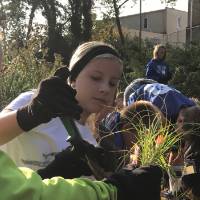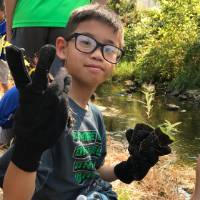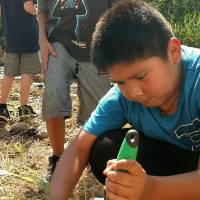Sparta Area Schools
Project Description:
Sparta students planted about 3,500 native plants on both sides
of a ditch located between the parking lot and back field of a ball
diamond at Sparta Middle School. The ditch is about 140 yards long and
eight yards wide. Storm water exits from the ditch to Rogue River.
Students investigated the effect native plants have on water quality
and habitat restoration in a storm water ditch. Through persuasion
letters and short presentations to local governments and other
classrooms, students persuaded others to help restore habitat and
their watershed by planting native plants.
Fostering Lifelong Stewardship:
Students experienced identifying a problem in their community and
were empowered to solve it.
Partners:
Peace Lutheran Church, Designs by Nature, Sparta Village Water Dept
Teachers:
3
Students:
175
Funder:
Baldwin Foundation
Showcase Video:
https://www.youtube.com/watch?v=LHPPTcqgBpA
Project Description:
This year's project added to the restoration of the banks of Nash
Creek. The goal of the project was to plant native plants to protect
the banks from erosion, improve water quality, provide habitat, and
educate the community on the beauty and functionality of native
plants. Community groups partnered with our classes to prepare the
banks, clear the site, plant native wildflowers, grasses, trees, and
shrubs, and maintain them. The area is located between Sparta Library
and a village park, connected by pedestrian bridge. Sixth and seventh
grade students performed water quality monitoring. A high school
biology class put native plant identification on the village website.
During Town and Country Days, 2017, students had a booth explaining
the project.
Fostering Lifelong Stewardship:
Prior to this project, the Sparta community was largely
uninformed about Nash Creek and its role in the local watershed. Now,
students proudly tour the project with their families. Every single
child or teen has tiptoed around seedlings while they fish or explore.
Community members approach teachers and ask where they can get native
plants for themselves. This year the bank restoration extended off
school property. Vandalism and trash have dropped off significantly
since the planting project began in 2008.
Partners:
Sparta Rotary, Sparta Boy Scouts, Sparta Girl Scouts, Kent
Conservation District, Summit Tree Service, Afton Excavating, Sparta
Village DPW, Mike Bruggink (landscape architect), Trout Unlimited,
Designs by Nature, Rogers Hardware, Various community members
Teachers:
3
Students:
420
Funder:
U.S. Environmental Protection Agency through the Michigan
Department of Environmental Quality
Showcase Video:
https://www.youtube.com/watch?v=_6SVyyS64DU
Project Description:
Students and teachers continued the Nash Creek Streambank
Restoration Project with Phase 2 by planting more native plants on the
banks of Nash Creek on both sides of the pedestrian bridge. (This site
was cleared for planting during Phase 1.) Phase 2 happened on October
7, 14, and 21, when third-, fourth-, and fifth-graders planted an
additional 2,000 plants to solve the problem of stormwater runoff
entering Nash Creek. Students also designed a sign in partnership with
Trout Unlimited to inform the community about roots of native plants,
information about some species planted, and donors who are made the
project possible. The sign was placed near the bridge.
Fostering Lifelong Stewardship:
Students used scientific facts and processes to solve problems.
They become personally connected to and responsible for Nash Creek,
which flows in the middle of their community. They are able to explain
how native plants restore their watershed.
Partners:
Trout Unlimited, Sparta Education Foundation, Designs by Nature
Teachers:
4
Students:
525
Funder:
U.S. Environmental Protection Agency through the Michigan
Department of Environmental Quality
Showcase Video:
https://www.youtube.com/watch?v=b1XbnvP6FJU
Project Description:
Third through fifth-grade students learned about an invasive
species, reed canary grass, which was planted as a substitute for hay
by settlers, and its negative effect on our watershed, specifically at
Nash Creek. An herbicide was sprayed professionally to eradicate reed
canary grass, and students replaced it with native plants. Afterwards,
students had a classroom lesson demonstrating how native plants absorb
pollution from stormwater and layers of sand clean the groundwater,
and native plants. Sixth-grade students researched and designed
bioswales located in the parking lot attached to Nash Creek to capture
stormwater from non-point source pollution, as a real-world
application in their own community of Sparta. Students pulled and
removed another invasive species, garlic mustard, which was growing
farther north on the same bank of Nash Creek. Then they spread an
organic material of leaves, twigs, and branches to keep native plant
roots moist and enrich the soil in that area.
Fostering Lifelong Stewardship:
Students now feel empowered to protect the watershed in which
they and other plant and animal species live. They feel attached to a
place of nature in their own community at a location they can easily
access. Students are now able to observe stormwater and where it
flows. They can identify invasive reed canary grass and garlic mustard
as hazards to the environment. Students can explain to others how they
increased habitat and clean water with beautiful native plants, as an
example for them to do the same.
Partners:
Designs by Nature, Sparta Education Foundation, Sparta DPW, Trout Unlimited
Teachers:
6
Students:
630
Funder:
Baldwin Foundation
Showcase Video:
https://www.youtube.com/watch?v=YtDMJs3eQes
Project Description:
During September’s monthly Flex Friday Science activities,
students explored adaptations between native wildflowers and bumble
bees in the wildflower garden at Appleview. In March, 5th graders
collaborated and developed a plan showing which wildflowers to plant
and where to plant them along a bank of Nash Creek in Balyeat Field.
Students included a variety of plants that would flower in the spring,
summer, and fall and thrive in dry, moist, and wet areas on the bank.
On May 10, 5th graders pulled garlic mustard and planted shrubs. On
May 24, 4th graders planted wildflower seedlings. On June 1, 3rd
graders planted in a shaded area on the north end of the bank, which
is cared for by Sparta Township. On June 6, students volunteered to
plant seedlings after school (usually 15-20 students participate). On
July 2, the Green Team, Trout Unlimited, completed planting on the
steepest parts of the bank.
In a surprise turn of events, Sparta Village was chosen by ReLeaf
Michigan, a non-profit tree organization, to plant 40 trees in Rogers
Park and Balyeat Field through which Nash Creek flows! Most will be
native trees that can tolerate suburban areas, are important to
pollinators, and improve the watershed. School and community
volunteers planted them on June 8.
Fostering Lifelong Stewardship:
Students know bees are being threatened. They have the power and
ability to improve habitat for bees. Students experience and
internalize that it could not be done without human intervention.
Students will witness plants maturing and bees and butterflies
pollinating them for many years. They will observe other native
species increasing in and out of the creek. Students feel connected to
Nash Creek and village parks and voluntarily take care of them.
Partners:
Sparta Education Foundation, Sparta Township, ReLeaf Michigan,
Sparta Village, Sparta Rotary
Teachers:
1
Students:
560
Funder:
MiSTEM
Showcase Video:
https://youtu.be/TxCo4haa2iM
Project Description
We are creating nature trails out of 2 ½ acres of a semi-woodland property which was dominated with invasive shrubs and plants. The school owns this property, which is bordered by Appleview Elementary and the Middle School. They are also within walking distance to Ridgeview Elementary and the High School. Students and community members have removed most of the invasive Japanese honeysuckle, bartlett pears, garlic mustard, floribunda rose, and spotted knapweed. Third - 5th graders are creating signs which will be placed at native trees and shrubs to educate Sparta students and community. Signs identify the species (4th grade standards); tell how it provides a service for the ecosystem and identify relationship between the plant and insects (3rd grade); identify invasive species and human effect on the environment (5th grade).
In September 2020, 32 large trees and 120 small bushes and trees were planted. The nature trails have a variety of habitats: rows of red pine planted in 1960, a north wooded, moist clay wooded area, a south wooded sandy area, and two small prairies. Sparta Hunting and Fishing Club has cut and delivered logs for a wooded classroom seating area and local farmers donated rocks for a seating area on a prairie. SHFC woodworkers built benches and trail signs. By the end of May, 2021, twenty more large trees, 5 flats of wildflowers, and 60 shrubs will be planted. Depending on grant funding, ten more large trees, 120 shrubs and more wildflowers will be planted in September, 2021
Partners:
Sparta Education Foundation, Michigan Department of Natural Resources, DTE Energy, Lower Grand River Organization of Watersheds, Sparta Department of Public Works, Sparta Hunting and Fishing Club, Sparta Community Foundation, National Park Foundation, Kingsbury Farms, Kent County Conservation District, Ace Hardware
Teachers:
16 total classes (six 3rd-grade; five
4th grade; five 5th grade classes)
Students:
400
Funder:
Baldwin Foundation, Wege
Foundation, Sparta Education Foundation, Michigan Department of
Natural Resources, DTE Energy, Lower Grand River Organization of
Watersheds, Sparta Community Foundation, National Park Foundation
Showcase Video: https://www.youtube.com/watch?v=Gp98sXptRko
Project Description:
We are creating nature trails out of 2 ½ acres of a semi-woodland property which was dominated with invasive shrubs and plants. The school owns this property, which is bordered by Appleview Elementary and the Middle School. They are also within walking distance to Ridgeview Elementary and the High School. Students and community members have removed most of the invasive Japanese honeysuckle, bartlett pears, garlic mustard, floribunda rose, and spotted knapweed. Third - 5th graders are creating signs which will be placed at native trees and shrubs to educate Sparta students and community. Signs identify the species (4th grade standards); tell how it provides a service for the ecosystem and identify relationship between the plant and insects (3rd grade); identify invasive species and human effect on the environment (5th grade).
In September 2020, 32 large trees and 120 small bushes and trees were planted.
The nature trails have a variety of habitats: rows of red pine planted in 1960, a north wooded, moist clay wooded area, a south wooded sandy area, and two small prairies.
Sparta Hunting and Fishing Club has cut and delivered logs for a wooded classroom seating area and local farmers donated rocks for a seating area on a prairie. SHFC woodworkers built benches and trail signs.
By the end of May, 2021, twenty more large trees, 5 flats of wildflowers, and 60 shrubs will be planted. Depending on grant funding, ten more large trees, 120 shrubs and more wildflowers will be planted in September, 2021
Fostering Lifelong Stewardship:
Respect and not damage plants, insects, small animals and their homes in a natural setting.
Tell others about invasive species and choosing native species of plants.
Become a model for youth and adults as a steward of the environment, school, and community
Choose to go outside, rather than stay inside.
Partners:
Sparta Education Foundation, Michigan Department of Natural Resources, DTE Energy, Sparta Department of Public Words, Sparta Hunting and Fishing Club, Sparta Community Foundation, Kingsbury Farms, Kent County Conservation District, Ace Hardware
Teachers:
Sue Blackall, Environmental & Outdoor Educator, K-12
Students:
400
Funder:
The Wege Foundation
Showcase Video: https://www.youtube.com/watch?v=22KbU2zsRKg&list=PLV2DqaYFEsPwEUUHkVf4EWeARMMgZa9NL&index=22&ab_channel=GroundswellMichigan
Project Description:
Timing for parts of the Middle School Rain Garden Ditch had to be changed. Last winter we had permission to have a prescribed burn early this spring, then classes would have planted this spring. Mrs. McKellar’s STEM classes would have been able to “tell the story” to educate the Sparta community and schools about how to, “Save the Great Lakes one rain garden at a time.” However, Sparta’s new superintendent, Joel Stoner, and Sparta’s fire chief, Dan Onley, will not allow a prescribed burn, even though the company we were going to hire would have insurance. So I contacted Ken Yonker, Kent County Drain Commissioner. He has given permission to use an herbicide that is safe for water to prepare the banks for planting this fall. Kent Conservation District will spray the banks twice this summer. Then students will plant wildflowers, bushes, grasses, and sedges this fall. During May all of the fourth and fifth grade classes and “That One Team” Robotics Team removed tall stems from the ditch to prepare for Kent Conservation District’s site preparation. An article with a picture has been submitted to “The Sparta Today” newspaper.
Sixth-eighth grade STEM classes researched how people can limit polluting stormwater runoff to help the watershed and how native plants can clean stormwater runoff as well as provide critically diminishing habitat. They were used for the Showcase and will be used to teach each classroom why we are planting in the fall. A huge professional stormwater tri-fold showing why and howfrom Sparta Village’s stormwater plan was also displayed at the Middle School until May 15. Since then it has been displayed at Appleview.
Next fall the ditch will be planted and STEM classes will create more publications about the project. In light of the drought we are having this May, a fall planting is much better! Roots will be able to take Michigan winters and summers!
Fostering Lifelong Stewardship:
Multiple grades are using this real world connection in each grade level science curriculum. Students understand the importance of educating others to influence others about taking care of the environment.
Partners:
That One Team Robotics Group, Sparta Schools Grounds Crew, Kent County Drain Commissioner Ken Yorker, Kent Conservation District
Teachers:
Sue Blackall, All Grades, Outdoor Education; Ericka McKellar, 6th, 7th, & 8th Grade, Science, Technology, Engineering & Math; All 4th Grade Sparta Elementary School Classes; All 5th Grade Sparta Elementary School Classes
Students:
420
Funder:
Wege Foundation, Sparta Education Foundation, Rogue River Partners, Wildflowers Association of Michigan
Showcase Video: https://youtu.be/35adV8aiogA
Project Description:
Sparta Middle School STEM classes and Appleview 3rd-5th grade STEM
classes are transforming a county ditch with a small creek running
through it into a plant rain garden to clean stormwater runoff and
provide native habitat. The creek flows directly into the Rogue
River. The rain garden ditch is an educational opportunity to teach
other classes and the Sparta Community about the importance of taking
care of the watershed. It is within walking distance to all of the
school buildings and a connected parking lot is available to the community.
The Kent Conservation District and Sparta DPW, as well as
community groups and volunteers, prepared the ditch for planting,
including holes with a drill plant auger. Posters created last spring
by the Middle School STEM classes will be used to explain and engage
classes before planting seedlings. Middle School students will team
up with Appleview students and teach their partners how to plant
seedlings. Middle School STEM classes will make a documentary of the
project and post it in schools and village sites to educate the
community by early Spring 2024. It will encourage other classes to
walk to the rain garden ditch for real-world science lessons. Their
story will inspire citizens to reduce pollution. Seeing beautiful
native plants and insects will be in the community’s own landscaping.
Students will learn how invasive species negatively affect the
environment and how to weed them before they get out of control.
Fostering Lifelong Stewardship:
During the mini-lesson, it was obvious that very few students knew that the Rogue River empties into the Grand River, although some knew that the Grand River empties into Lake Michigan. It is a very concrete connection to understand how the seedlings they plant clean stormwater and create a habitat that would not exist if they did not plant it. Every student in Sparta has heard the message and planted a Groundswell project since 2009-the first class graduating year in 2018 and every year since!
Partners:
Majestic Landscaping Services, Kent County Drain Commissioner, Kent Conservation District, Sparta Education Foundation, Sparta Village DPW, Rogue River Partners, Go Grow Plant Native, LLC Owner, Retired DNR biologist and owner of Designs by Nature, High School volunteers, Wildflower Association of Michigan
Teachers:
Sue Blackall 3rd-5th Outdoor education/science, Ericka McKellar 7th-8th STEM, David Oudbier 3rd-5th STEM
Students:
590
Funder:
National Oceanic and Atmospheric Administration (NOAA)
Showcase Video: https://youtu.be/xLYpkiWguIs?si=5mmEeJiLUl_0iedo
Project Description:
Students restored an 80-yard by 50-yard section of wetland that was cleared of mostly dead ash trees in Sparta Nature Park, which borders the Rogue River.
Partners:
Rogue River Watershed Organization, Village of Sparta, Kent
Conservation District
Teachers:
Sue Blackall
Students:
304
Funder:
Great Lakes Fishery Trust





